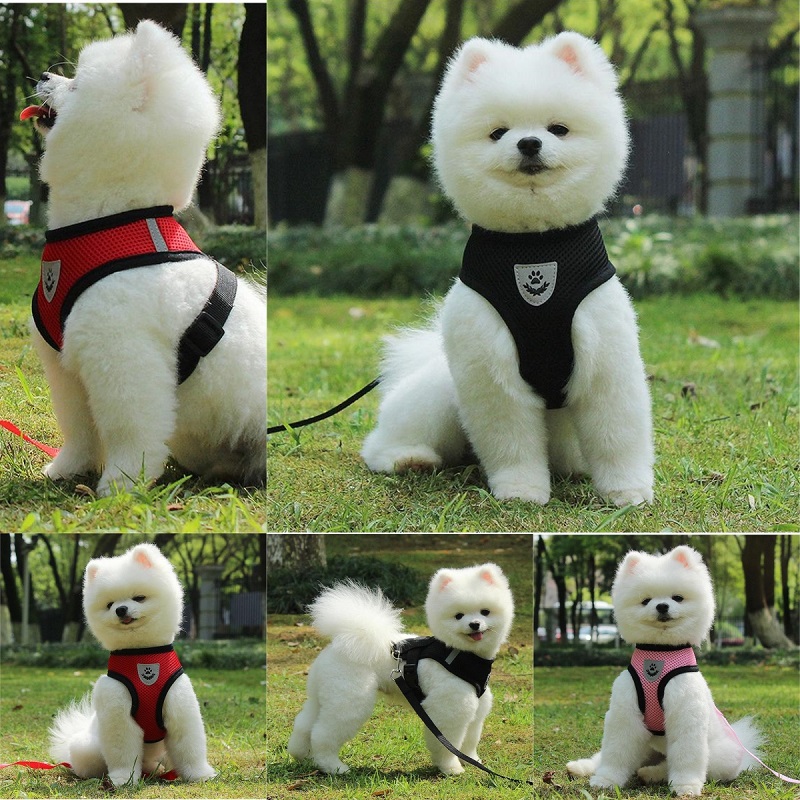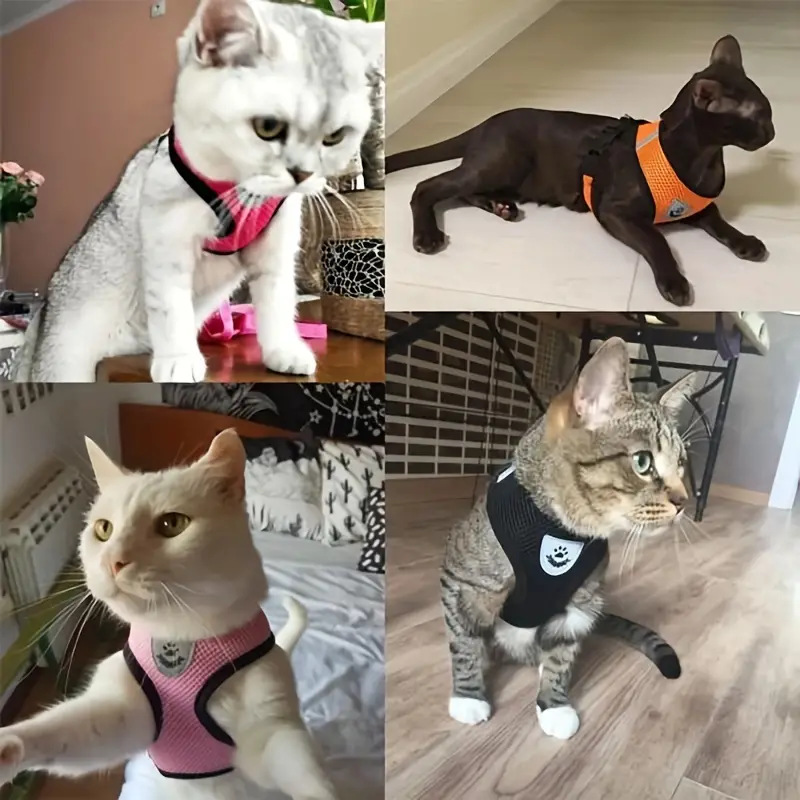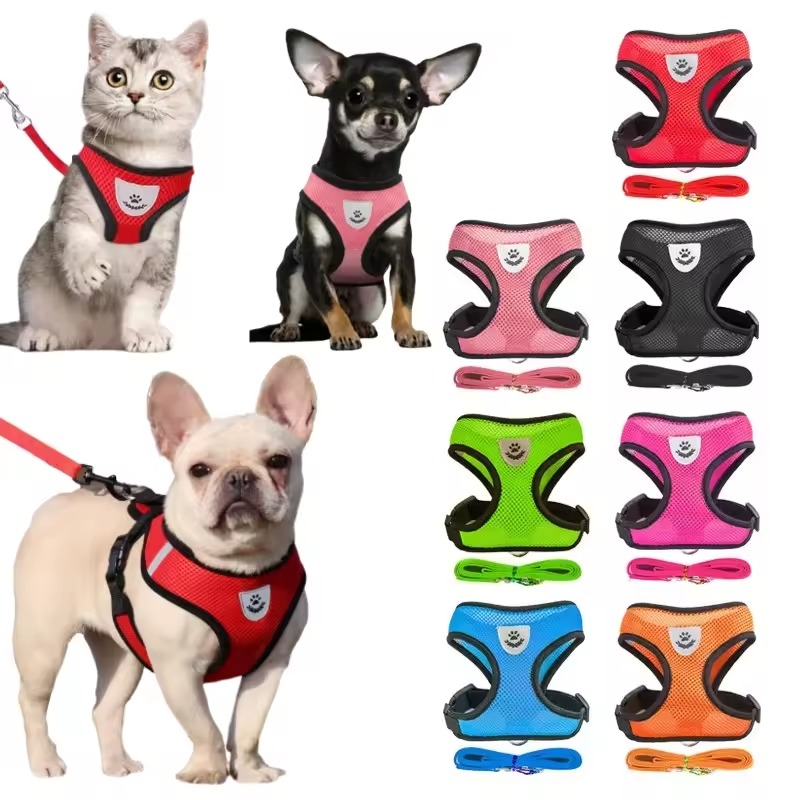Important Features to Look for in a Harness
When shopping for a dog harness for small dogs, consider several key features. A good harness should fit snugly without causing any discomfort. Look for adjustable straps that ensure a secure fit. A harness should also distribute pressure evenly across the body to avoid strain on your dog’s neck and back. Breathable materials are important, especially for active dogs or those in warmer climates. Reflective elements are a great addition for visibility during nighttime walks. Finally, ensure the harness has a sturdy D-ring for leash attachment and easy-to-use buckles for convenience.

The Benefits of a Properly Fitted Harness for Small Dogs
A well-fitted dog harness for small dogs offers many benefits. It boosts safety by preventing your dog from slipping out and getting lost. A snug harness makes control easier during walks, reducing pulling and tugging. This helps train your dog better. It also improves comfort, preventing chafing and reducing stress on your dog’s neck. With a proper harness, pressure spreads across the chest, protecting the delicate throat area. A well-chosen harness can even enhance posture, supporting your dog’s gait. This is especially important for small breeds prone to musculoskeletal issues. Ultimately, a properly fitted harness promotes a more enjoyable walk for both you and your furry friend.
Types of Dog Harnesses Suitable for Small Breeds
When choosing a dog harness for small dogs, you’ll find various types designed to match different needs and preferences. Here’s a breakdown of common harness types for small breeds:
- Step-in Harnesses: Ideal for calm dogs, these harnesses allow your pet to step into the loops for a quick fit. They distribute pressure well and are simple to use.
- Overhead Harnesses: You slip these over your dog’s head and they often offer more coverage and support. They are adjustable and provide good control during walks.
- Vest Harnesses: These are soft and often padded for extra comfort. They’re suitable for dogs with sensitive skin and can be very stylish.
- Front-clip Harnesses: These have a leash attachment in the front and can discourage pulling. They’re helpful for training small dogs to walk by your side.
- Dual-clip Harnesses: Offering both front and back leash attachments, they give you the option to switch based on your training session or walk style.
- No-pull Harnesses: Specifically made to reduce pulling, these harnesses tighten slightly when a dog pulls on the leash. They’re useful for teaching good walking behaviors.
Each harness type has its own benefits. The right one for your small dog depends on their size, temperament, and your walking routine. Always prioritize comfort, fit, and safety when selecting a harness. Remember, a properly fitted harness can make all the difference for your small breed dog’s well-being and your peace of mind during walks.
How to Measure Your Small Dog for the Perfect Harness Fit
Finding the right size dog harness for small dogs is crucial. A misfit can lead to discomfort or escape. To measure your dog accurately, you will need a flexible tape measure. Here’s a simple step-by-step guide:
- Neck Measurement: Wrap the tape around the base of your dog’s neck. Ensure it’s snug but not tight. Note the measurement.
- Chest Girth Measurement: Measure the widest part of your dog’s chest. Again, the tape should be snug but not tight.
- Length Measurement: Some harnesses require a length measurement. Measure from the base of the neck to the base of the tail.
After measuring, check the size chart for each harness brand. Size charts can differ, so rely on your dog’s measurements. Choose a harness that allows for some adjustment. Your small dog may gain or lose weight, or need a tighter fit for security or a looser fit for comfort. Remember to re-measure your dog every few months, as changes in size can occur.
Proper fit is the key to preventing injury and escape. A good harness should allow two fingers to fit between the harness and your dog’s body. This ensures the harness is tight enough not to slip off while providing enough room for movement and breathing.
By taking the time to measure your dog correctly, you are taking a vital step in ensuring their safety and comfort during walks. Using the right dog harness for small dogs will create a positive walking experience for both you and your furry companion.

The Role of Material and Durability in Harness Selection
When selecting a dog harness for small dogs, material and durability are crucial. The right material ensures comfort and suits your dog’s skin type. Durability affects how long the harness will last. Both factors influence overall safety and value.
Comfort and Skin Sensitivity
Choose soft, breathable materials if your dog has sensitive skin. Mesh and padded neoprene are popular for their comfort. They prevent chafing and allow air to circulate. This keeps your small dog cool during walks.
Weather and Lifestyle Considerations
If you live in a wet climate, look for waterproof materials. They dry quickly and resist odor. For active dogs, choose sturdy, lightweight fabrics. These withstand vigorous play without weighing your pet down.
Durability for Daily Use
A durable harness can handle daily walks and playtime. Nylon is known for its strength and longevity. It stands up to pulling and general wear and tear. Look for reinforced stitching and metal D-rings. These features help the harness last longer.
Easy to Clean
Your small dog’s harness will get dirty. Opt for materials that are easy to clean. Machine washable harnesses save time and effort. Quick-drying fabrics are a bonus after washes or rainy walks.
Consider these factors to find a harness that will stay comfortable and hold up over time. The right material and build give you the best value and keep your small dog safe on every adventure.
Popular Dog Harness Brands for Small Breeds
Choosing the right dog harness for small dogs also involves selecting a reputable brand. Some popular brands that cater to small breeds include:
- Puppia: They offer soft and adjustable harnesses, known for their comfort and fit.
- Ruffwear: This brand provides durable harnesses suitable for more active small dogs.
- Kurgo: Kurgo designs harnesses with outdoor adventures in mind, with added safety features.
- PetSafe: They are recognized for no-pull harnesses that help with training small dogs.
- Blueberry Pet: Fashionable and functional, their harnesses come in various colors and patterns.
- Pawtitas: Focused on eco-friendly materials, their harnesses also feature reflective strips for safety.
Select a brand that aligns with your dog’s size, activity level, and your personal preferences. Make sure the harness materials are suitable for your small dog’s skin and the level of activity. Also, consider upkeep; easy-cleaning options are practical for busy pet owners.
When looking at brands, read customer reviews. These can offer insights into fit, durability, and customer satisfaction. Look for feedback from owners of small breeds to gauge how the harness might work for your dog.
Finally, keep in mind that while brand reputation is important, the best fit and comfort for your dog should always be the priority. Match the brand’s offerings with your dog’s individual needs to ensure they are comfortable and secure on their walks.
Tips for Introducing Your Small Dog to a New Harness
Introducing a new dog harness for small dogs requires patience and positive reinforcement. It’s crucial to make the experience stress-free and pleasant. Here are some tips to help your small dog get used to their new harness:
- Start with Sniffing: Let your dog sniff the harness. This allows them to become familiar with it before wearing it.
- Associate with Treats: Give your dog treats while they’re investigating the harness. This creates positive associations.
- Gradual Introduction: Place the harness on your dog for short periods at first. Slowly increase the time as they get comfortable.
- Keep it Positive: Use encouraging words and positive body language. Avoid forcing the harness on if your dog resists.
- Practice Indoors: Begin by letting your dog wear the harness inside the house. This helps them adjust in a familiar environment.
- Short First Walks: Once your dog is comfortable, take short walks to get them used to the harness outside.
- Watch for Discomfort: Observe if your dog shows signs of discomfort. Adjust the harness if needed, ensuring it’s not too tight or loose.
- Consistent Routine: Use the harness consistently during walks. This helps your dog understand it’s part of their regular routine.
Remember to reward your dog for cooperation. With time and positive experiences, your small dog will feel at ease with their new harness.
Maintenance and Care for Small Dog Harnesses
To keep your small dog’s harness in top condition, regular maintenance and care are key. Here are practical steps provided for lasting harness life:
- Check for Wear and Tear: Before each use, examine the harness for any signs of damage. Look for frayed straps, loose threads, or weak buckles.
- Clean Regularly: Clean the harness as needed. If it’s machine washable, follow the laundering instructions. For other materials, use a damp cloth and mild soap.
- Dry Properly: After washing or a rainy walk, let the harness air-dry completely. Avoid placing it in direct sunlight or near high heat.
- Store Correctly: When not in use, hang the harness in a dry place. Keep it away from the floor to prevent chewing or tangling.
- Adjust as Needed: Make sure the harness fits well each time. Adjust straps for comfort and security.
- Replace When Necessary: Don’t wait for a total breakdown. If the harness shows significant wear, replace it for your dog’s safety.
By following these simple steps, you ensure the dog harness for small dogs remains comfortable, safe, and functional. Good care extends the life of the harness and supports enjoyable walks for you and your pup.
